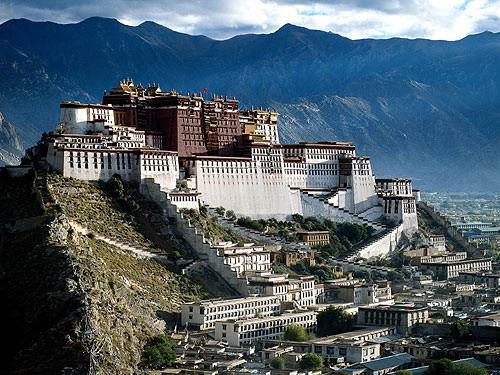
The 14th Dalai Lama
Tibetan Buddhists believe the Dalai Lama to be one of innumerable incarnations of the bodhisattva of compassion. Dalai Lama means Ocean of Wisdom.
Between the 17th century and 1959, the Dalai Lama was the head of the Tibetan government, administering a large portion of the country from the capital Lhasa. The Dalai Lama is considered the supreme head of Tibetan Buddhism, and the leaders of all four schools of Buddhism consider the Dalai Lama to be the highest monk of the Tibetan traditions.


The Potala Palace, residence of Dalai Lama in Lhasa, Tibet
In 1950, at age 16, His Holiness was called upon to assume full political power as Head of State and Government when Tibet was threatened by the might of China.
In 1959 the capital of Tibet, Lhasa, exploded with the largest demonstration in Tibetan history, calling on China to leave Tibet and reaffirming Tibet's independence. The Tibetan National Uprising was brutally crushed by the Chinese army. When China occupied Tibet, the 14th Dalai Lama sought refuge within India. The then Indian Prime Minister, Jawaharlal Nehru was instrumental in granting safe refuge to the Dalai Lama and his fellow Tibetans. The Dalai Lama has since been in refuge in Dharamsala, in the state of Himachal Pradesh in northern India, where the Central Tibetan Administration (The Tibetan Government in Exile) is also established. Tibetan refugees have constructed and opened many schools and Buddhist temples in Dharamsala.

Little monk in Dharamsala.
In the early years of exile, His Holiness appealed to the United Nations on the question of Tibet, resulting in three resolutions adopted by the General Assembly (in 1959, 1961 and 1965) calling on China to respect the human rights of Tibetans.
In Washington D.C., at the Congressional Human Rights Caucus in 1987, The Dalai Lama proposed a Five-Point Peace Plan, calling for the designation of Tibet as a zone of peace, an end to the massive transfer of ethnic Chinese into Tibet and the abandonment of China's use of Tibet for nuclear weapons production.

Recieving Nobel Peace Prize
The awarding of the 1989 Peace Prize to His Holiness won worldwide praise and applause, with exception of China. His Holiness accepted the prize on the behalf of all those who struggle for freedom and work for world peace, and of course, the people of Tibet. In his remarks he said,
"The prize reaffirms our conviction that with truth, courage and determination as our weapons, Tibet will be liberated. Our struggle must remain nonviolent and free of hatred."
The current Dalai Lama repeatedly states that he will never be reborn inside territory controlled by the People's Republic of China, and has occasionally suggested that he might choose to be the last Dalai Lama by not being reborn at all. However, he has also stated that the purpose of his repeated incarnations is to continue unfinished work and as such, if the situation in Tibet remains unchanged, it is very likely that he will be reborn to finish his work.
His Holiness often says, "I am just a simple Buddhist monk - no more, nor less."
He follows the life of Buddhist monk. Living in a small cottage in Dharamsala, he rises at 4 A.M. to meditate, pursues an ongoing schedule of administrative meetings, private audiences and religious teachings and ceremonies. He concludes each day with further prayer before retiring.
Such is the beauty and brilliance of the Dalai Lama. 48 years ago, he had been forced into India - and yet, he continues to fight and struggle for his lost land, in a peaceful way.
Peaceful, but Powerful.
